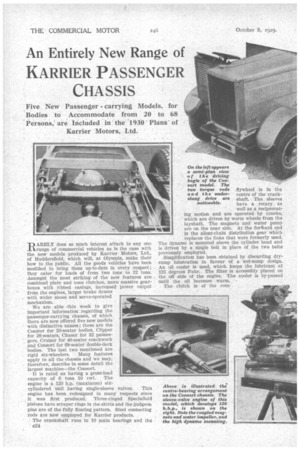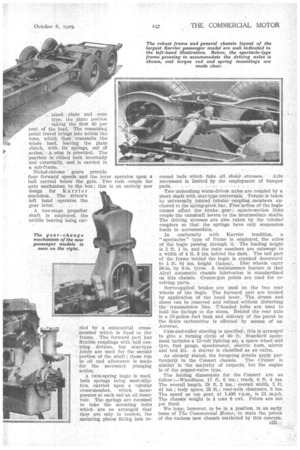An Entirely New Range of KARRIER PASSENGER CHASSIS
Page 62

Page 63

If you've noticed an error in this article please click here to report it so we can fix it.
Five New Passenger carrying Models, for Bodies to Accommodate from 20 to 68 • Persons, are Included in ' the '1930 Plans of Karrier Motors, Ltd.
1101 ARELY does so much interest attach to any one
range of commercial vehicles as is the case with the new models produced by Karrier Motors, Ltd., of Huddersfield, which will, at Olympia, make their bow to the public. All the goods vehicles have been modified to bring them up-to-date in every respect; they cater for loads of from two tons to 12 tons. Amongst the most striking of the new features are combined plate and cone clutches, more massive gearboxes with ribbed casings, increased power output from the engines, larger brake drums
with wider shoes and servo-operated mechanism.
We are able this week to give important information regarding the passenger-carrying chassis, of which there are now offered five new models with distinctive names ; these are the Coaster for 20-seater bodies, Clipper for 26-seaters, Chaser for 32 passengers, Cruiser for 40-seater coachwork and Consort for 68-Seater double-deck bodies. The last two mentioned are rigid six-wheelers. Many features apply to all the chassis and we may, therefore, describe in some detail the largest machine—the Consort.
It is rated as having a gross-load capacity of 6 tons 10 cwt. The engine is a 120 h.p. (maximum) six cylindered unit having single-sleeve valves. This engine has been redesigned in many respects since it was first produced. Three-ringed Specialloid pistons have scraper rings in the skirts and the gudgeon PiaS are of the fully floating pattern. Steel connecting rods are now employed for Karrier products.
The cranksha-ft runs in 10 main bearings and the c24
noticeable.
flywheel is in the centre of the crankshaft. The sleeves have a rotary, as well as a reciprocating motion and are operated by cranks, which are driven by worm wheels from the layshaft. The magneto and water pump are on the near side. At the forTvard end is the silent-chain distribution gear which replaces the links that were formerly used. The dynamo is mounted above the cylinder head and is driven by a single belt in place of the two belts previously employed.
Simplification has been obtained by discarding drysump lubrication in favour of a wet-sump design. An oil cooler is used, which keeps the lubricant at 125 degrees Fahr. The filter is accessibly placed on the off side of the engine. The cooler is by-passed until the oil becomes warm.
The clutch is of the com
blued plate and cone type, the plate portion taking the first 40 per cent. of the load. The remaining Pedal trayel brings into action th3 Cone, which then transmits the whole load, leaving the plate clutch, with. its springs, out d action. A stop is provided. The gearbox is ribbed both internally and externally, and is carried in a sub-frame.
Nickel-chrome gears .provide four forward speeds and the lever operates upon a ball carried below the gate. Two rods couple the gate mechanism to the box; this is an entirely new design for Karrier machines. The, driver's ,Ieft hand operates the gear lever..
• A two-stage propeller .shaft is employed, the middle bearing being car
rind by a substantial cross...member which is fixed to the frame. The forward part has flexible couplings with ball centring devices, but star-type joints are used for the second portion of the shaft; these run in' oil and allowance is made for the necessary plunging action: A twin-spring bogie is used, both springs being semi-elliptics, carried upon a tubular cross-member, which incorporates at each end an oil reservoir. The springs are recessed to take the mounting bolts which are so arranged that they are only in tension, the mounting plates fitting lath re cessed .beds which take. ail, shear•-.stresses. Axle movement is limited by the employment. of bumper Two underslung worm-driven axles are coupled by a short shaft with star-type universals. Torque is taken by universally jointed tubular couplingonembers anchored to the spring-pivot,bar. Free'action of the bogie cannot affect the \ brakegear; square-section links couple the camshaft levers ,to the intermediate shafts. The driving stresses are also taken by the tubular couplers so that the springs have only'suspension
loads to accommodate. '
In conformity with Karrier tradition, a "spectacles" type of frame is employed, the axles of the bogie passing through it. The loading height is 2 ft. 1 in. and tile main members are outswept to a width of 4 ft. 3 ins, behind the dash. The tail part of the frame behind the bogie is cranked downward to 1 ft. 8i ins. height (laden). Disc wheels carry 36-in. by 8-in. tyres. A maintenance feature is that Alcyl automatic chassis lubrication is standardized on this chassis. Grease-gun points are used for revolving parts.
Servo-applied brakes are Used on the two rearrn wheels of the bogie. The forward pair are braked by application of the hand lever. The drums and shoes can be removed and relined without disturbing the ' transmission line. T-headed bolts are used to hold the facings to the shoes. Behind the rear axle is a 53-gallon fuel tank and delivery of the petrol to the Solex carburetter is effected by means of an Autovac,
Cam-and-roller steering is specified; this is arranged to give a turning circle of 60 ft: Standard equipment includes a 12-volt lighting set, a spare wheel and tyre, fuel gauge, speedometer, electric horn, mirror and tool kit. A starter is classified as an extra.
As already stated, the foregoing details apply par ticularly to the Consort chassis. The Cruiser is similar in 'the majority of respects, but the engine is of the poppet-valve type.
The leading dimensions for the Consort are as follow :—Wheelbase, 17 ft. 6 ins.; track, 6 ft. 4 ins. The overall length, 28 ft. 2 ins.; overall width, Z ft. 4i ins.; body space, 23 ft.; rear-axle clearance, 6 ins. The speed on top gear, at 1,400 r.p.m., is 21 m.p.h. The chassis-. weight is 4 tons 8 cwt. Prices are not yet fixed. We, hope, however, to be in a position, in an early issue of The Commercial Motor, to state the prices Of the various new chassis marketed by this concern. c25




























































































































